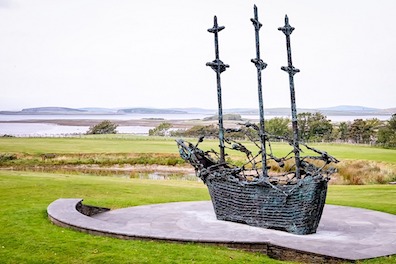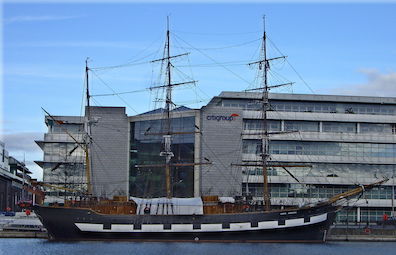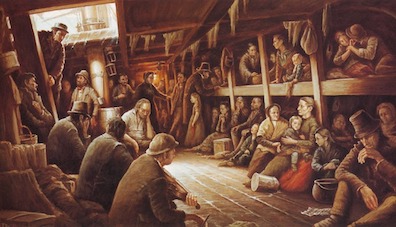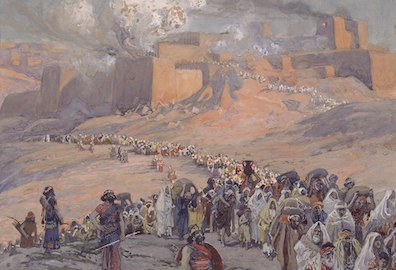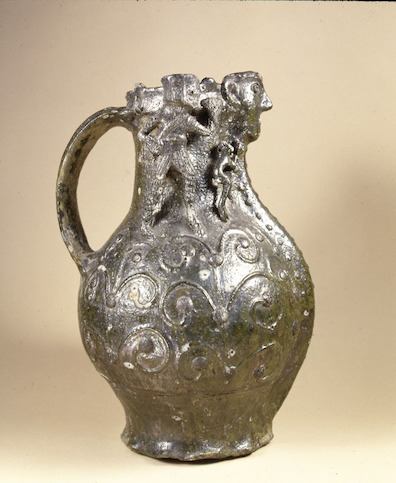In a 1907 lecture titled Ireland, Island of Saints and
Sages, Joyce said that "Ireland is poor because English
laws ruined the country's industries, especially the wool
industry," and "because the neglect of the English government
in the years of the potato famine allowed the best of the
population to die from hunger" (167). The Citizen's charges
particularize these two generalizations by identifying
industries ruined by English laws and quantifying the numbers
of people lost to death and emigration. In commenting on them
I will quote liberally from Gifford's well-researched
commentary in Ulysses Annotated.
"Where are our missing twenty millions of Irish should be
here today instead of four, our lost tribes?" This
reference to the Great Hunger
of the 1840s, which caused the starvation and emigration of
many millions of poor Irish, uses pretty good numbers. Gifford
remarks, "The population of Ireland in 1841 was 8,196,000; by
1851 it had fallen to 6,466,000. If, however, population had
continued to grow as it had in the two decades 1821
(6,800,000) to 1841 (8,196,000), the population at the end of
the century would have been approximately 18,000,000. The U.
S. census in 1900 estimated that approximately 4,000,000 Irish
had immigrated to the United States in the course of the
nineteenth century."
In that year, 1900, Ireland held only 3,231,000 people—fewer
than the 4 million emigrés, and far fewer than all the people
lost when the 1 million starved to death are factored in. The
effects of this catastrophic depopulation are still felt
today, when the population of the Republic has not yet reached
5 million and Northern Ireland has fewer than 2 million
inhabitants. These numbers (6-7 million) are a far cry from
what might reasonably have been expected even by 1900 (18-20
million) were it not for the criminally negligent British
government response to the famine. Indeed, they do not even
come up to pre-famine numbers (8 million). Despite the high
proportion of emigrants who succumbed to diseases on the
"coffin ships" crossing the Atlantic, the Irish population in
America has suffered no such stunted growth!
The phrase "our lost tribes" alludes to the conquering
Assyrians' deportation of many members of the kingdom of
Samaria (the ten northernmost tribes of ancient Israel's
twelve) in the 8th century BC and the Babylonians' deportation
of Judeans in the 6th. The two strategic depopulations,
sometimes jointly called the "Babylonian
captivity," devastated Israel just as the loss of more
than half its population in the 19th century devastated
Ireland. The equivalence between ancient Israel and modern
Ireland implied by "our lost tribes" coheres with symbolic
structures introduced in Aeolus, and Cyclops
will reinforce it several pages later when Joyce's Jewish
protagonist protests that his people too have been robbed,
dispersed, "sold by auction in Morocco like slaves or cattle."
It is massively ironic, though, that the most fiercely
anti-Semitic and anti-Zionist character in the novel should
make the comparison.
"And our potteries and textiles, the finest in the whole
world!" Some hyperbole is no doubt involved in the
Citizen's claim that Irish pottery and textiles surpassed all
others, but the thriving industries that he cites are a matter
of historical record, and their abrupt decline in the 19th
century is a fit subject for mourning. Slote cites the finding
of the Oxford New History of Ireland (vol. 5, pp.
lv-lviii) that "Before the Act
of Union, Ireland had been keeping pace with England in
terms of industrial advance, although by 1900, after a century
of union, Irish industries, such as textiles, stagnated." The
significance of the Act of Union in this assessment is that
from 1801 onward all laws affecting Irish manufacture and
trade were made in Westminster, not Dublin.
"And our wool that was sold in Rome in the time of Juvenal."
Wool was especially important in earlier centuries, as Joyce
observed in his lecture. Gifford notes that "there is little
hard evidence about trade between Ireland and Rome, though
historians assume that after the Roman conquest of England
'there must have been' a significant increase of commerce, and
Tacitus (c. 55-120 A.D.) in 100 A.D. remarks that Irish
harbors 'through commerce and merchants' were better known
than English harbors. Trade and manufacturing in wool appear
to have been of some importance in ancient Ireland, but the
continental reputation of Irish woolens was not established
until the sixteenth century; and from that time on the English
imposed a series of taxes and restrictions in the interest of
preventing Irish competition with the English wool trade."
(The Roman historian Tacitus lived at almost exactly the same
time as the Roman satirist Juvenal, whom the Citizen mentions
for some obscure reason.)
As for particular "textiles," the Citizen praises "our
flax and our damask from the looms of Antrim and our
Limerick lace." Northern Ireland did have a thriving
linen industry in earlier centuries. Gifford observes that
County Antrim "was the heart of the flax-growing,
linen-weaving industry in Ulster as early as the mid-sixteenth
century. Linen appears to have been the only Irish manufacture
that the English encouraged, but even that encouragement was
ambiguous, alternating with measures (as early as the 1690s)
designed to suppress the Irish linen industry in favor of its
English competition. The linen industry survived, however, to
emerge as the most important Irish industry through the
eighteenth century." The fine handmade lace produced in
Limerick was another industry that declined in the 19th
century. Gifford notes that this was "largely as a result of
competition from machine-made lace," a casualty which cannot
be blamed on British government policy.
The Citizen goes on to menion "our tanneries and our white
flint glass down there by Ballybough." Ballybough was a
village just north of Dublin, now swallowed up in the suburb
of Fairview. Gifford observes that "Some pieces of glass,
identified as pre-Norman and therefore associated with ancient
Ireland, were found in caves near the village." It seems odd
that the Citizen does not mention the famous Irish glass
industry in Waterford. Gifford notes that "it flourished from
the 1690s until 1745, when it was suppressed, and then again
briefly in the last quarter of the eighteenth century." The
Waterford Glassworks company resumed production in 1783,
manufacturing fine pieces of cut crystal, but it went out of
business in 1851, eliminating nearly 100 jobs.
It seems a bit odd to celebrate "our Huguenot poplin,"
and even odder to say that the country has had it "since
Jacquard de Lyon." Poplin is a cloth invented in France
and brought to Ireland with the arrival of Huguenot refugees in the late
17th century, so it is more French than Irish, and Joseph
Marie Jacquard was entirely French. The loom he invented
facilitated the manufacture of poplin, but it came to Ireland
more than a century after poplin did.
The list ends with "our woven silk and our Foxford tweeds
and ivory raised point from the Carmelite convent in New
Ross, nothing like it in the whole wide world." The
manufacturing of silk cloth is another industry that Huguenot
refugees brought to Ireland in the late 17th century. It too
died out, Gifford observes, "in the first half of the
nineteenth century (thanks to the technological advantage
achieved by English and continental manufacturers during the
Industrial Revolution)." Foxford, a village in County Mayo,
starting producing tweed in the 19th century. New Ross, a
village in County Wexford, has a long tradition of fine
needlepoint work. Gifford notes that "The Carmelites at New
Ross preserved some examples of ancient needlepoint and
imitated them in a small but famous industry."
The Citizen slightly exaggerates the number of people that
demographic trends might have produced by 1904 had the famine
not happened. He imagines as factual a wool trade with ancient
Rome that is only hypothetical. He waxes hyperbolical about
Irish goods. And he falsely implies English government
culpability in the failure of two or three Irish industries
that simply succumbed to more technologically advanced
competition. But even after accounting for these sloppy
exaggerations one must conclude that his picture of history is
largely convincing.
Professional historians could add other telling details to
his catalogue. The Citizen mentions "tanneries," for
instance, but not the fact that nearly all the cattle raised
in Ireland in his time were exported to England, or the fact
that the large Catholic majority had long been stripped of
their ancestral holdings and confined to the poorest 5% of the
arable land, or the fact that government shipping policies in
the 1840s had turned a recoverable disaster into a holocaust.
All these developments contributed enormously to the
depopulation of the island in the 19th century. One can say,
with or without prejudice, that English rule was ruinous for
Ireland, both demographically and economically.
